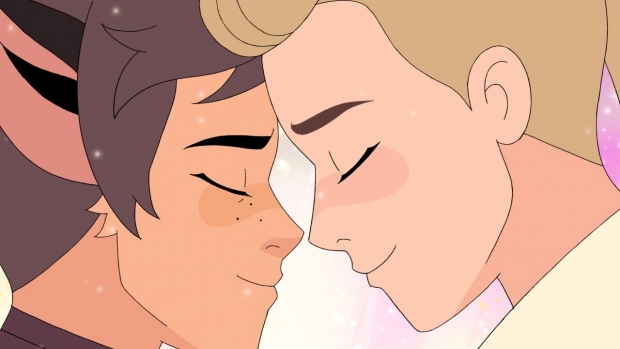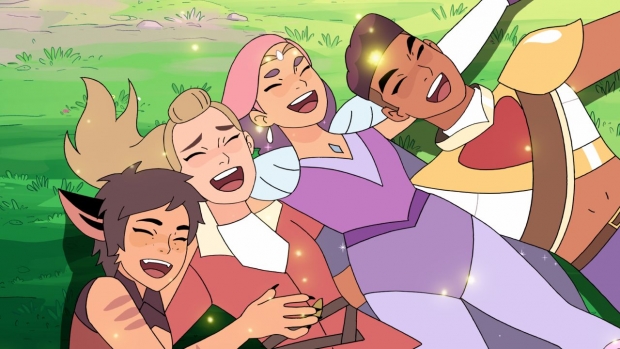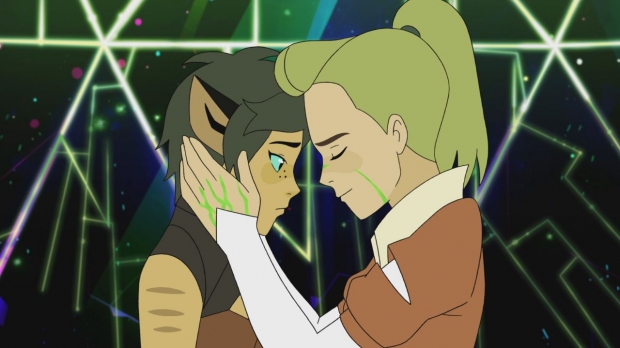Nominated for two Annie Awards, Noelle Stevenson and DreamWorks Animation’s hit series may have ended its five-season Netflix run, but it’s unflinching support for lifestyle diversity, and message that love and friendship will conquer the fear of failure, will continue to positively impact audiences well into the future.
Since the animated “Princess of Power” first appeared on screens in 1985, Noelle Stevenson says she believes the story of She-Ra has always been “glittery and queer,” which greatly influenced the way she approached her 2018 adaptation, the Netflix Original Series, DreamWorks Animation’s She-Ra and the Princesses of Power.
“The rainbows, the belly shirts, the queer coding, they were always a part of this property,” adds Stevenson, the show’s creator and executive producer. “But while the main cast was packed with powerful women, which was awesome, it was still a toy-driven show, which meant the characters were all cast in the same mold and looked very similar. I wanted to capture the core of what made the original She-Ra special and update it for modern audiences, and it felt really important to me that it was gay. I wanted our characters to be diverse in race, in body type, in personality, in orientation, and in gender identity to better reflect the world we live in and the audience who'd be watching. After all, there are so many different ways to be powerful.”
She-Ra and The Princesses of Power’s reboot - centered around a princess named Adora, who as the sword-wielding She-Ra leads a rebellion to save her home of Etheria from the corrupt ruler Hordak - has expanded upon the 80s classic with a plethora of diversity in both character identities and their viewpoints on relationships and strength. The story’s broad range of philosophies on power and love come to a head in the Season 5 and series finale, “Heart Part 2,” which has been nominated for two Annie Awards: Best Writing - TV/Media and Best TV/Media - Children. Stevenson’s series has previously garnered a Daytime Emmy Award as well as numerous other nominations, including a Golden Trailer Award for Best Animation/Family TV Spot, a Critics' Choice Television Award for Best Animated Series, and three for the GLAAD Media Award for Outstanding Kids & Family Programming.
“It's been incredible,” says Stevenson. “I could never have anticipated the size and enthusiasm of the response. So much of making a show is working on it for years before it's ever announced, and during that time all you can really do is just hope that it connects with people the way you want it to. So, to have it all be out, and to see people continue to connect with it and engage with it in all these different ways, it's such a relief. I'm so glad that people love it as much as we do.”
Kiki Manrique, a director, producer and storyboard artist on She-Ra, adds, “It was such an overwhelming feeling to have it out in the world. I wrapped on the show over a year before the final episode aired, so it was super hard to wait and keep quiet about it for so long. When it finally came out, to see it resonate with so many people, to see fans of the show picking up on all the small things we put into the episodes, it was so rewarding.”
The show’s final episode resolves Adora’s two biggest battles - with Horde Prime and with herself. As Adora leads her friends into a battle to save their brainwashed comrades and destroy a tyrannical empire, Catra - Adora’s best friend-turned-enemy-turned-friend again - tries to convince her that love, dedication, and strength don’t always have to mean self-sacrifice. As characters battle those they care for the most, Adora battles the voice inside her head that says she’s not good enough; in turn, she learns how to better express love for her friends, as well as recognize her and Catra’s long-time romantic feelings for each other.
“Heart Part 2” is filled with gut-wrenching psychological torment, heartwarming reunions, and some of the most vibrantly animated landscapes and high-contrasted battle sequences in the entire series, all leading up to the fan-favorite shot: Adora and Catra’s kiss, boarded by Mickey Quinn.
“I can't pretend my favorite moment isn't the kiss,” says Stevenson. “Catra and Adora's arc throughout the show and especially in Season 5 is really the series’ backbone. We've seen them break apart, sink into the depths of self-loathing, refuse help, and crack under the pressure in different ways while still paralleling each other.”
 And as Catra and Adora's story finally converges back together in Season 5, audiences see both characters struggle with their flawed ideas of love. “In Season 5, Catra's arc is about learning to be less selfish and open herself up to people besides Adora, and also that vulnerability is not a weakness,” Stevenson shares. “And Adora learns to be a little more selfish, and that loving one person and loving yourself and staying when people need you is just as heroic as offering up your life for them.”
And as Catra and Adora's story finally converges back together in Season 5, audiences see both characters struggle with their flawed ideas of love. “In Season 5, Catra's arc is about learning to be less selfish and open herself up to people besides Adora, and also that vulnerability is not a weakness,” Stevenson shares. “And Adora learns to be a little more selfish, and that loving one person and loving yourself and staying when people need you is just as heroic as offering up your life for them.”
But there was a point during the final episode’s development when the team wasn’t sure they could include the kiss. “I remember waiting with so much anticipation to see if we were actually going to be able to show it,” Manrique recalls. “We actually had to board a version where it could easily be a fade-to-white cut. We were all holding our breath for a while, and when Noelle finally delivered the news that the kiss was staying, we were all ecstatic.”
“We spent so long planning how to get that moment and how to make it really satisfying, and I don't think it really sunk in for me until I actually got to watch it on Netflix,” adds Stevenson. “It's such a special, triumphant moment.”
She continues, “I love that the climax of the show entirely hinges on a confession of gay love. It all comes down to the characters and their emotions in the end, and it's truly what the show has been building to for five seasons.”
In the face of production challenges such as having small crews, tight deadlines, and a bigger scope than budget, Stevenson and Manrique credit much of the show’s success to establishing the series’ focus on the characters, “above all else.” Some of the characters are even reflections of production members. “I think we pulled it off because we all believed in the story so much and we wanted it to exist so badly,” explains Manrique. “We put so much - maybe sometimes too much - of ourselves into the show, because we could see ourselves represented in it, which was a first for a lot of us.”
“We all had a character that was extra close to our hearts,” Stevenson notes. “So, when you see the characters' struggles, their hopes and fears, that's someone in the crew putting themselves into that character. And then, in turn, the audience sees themselves in those characters, because they're inspired from something real.”
For Stevenson, the character close to her own heart was Catra, whose journey - which shines brightest in the finale - has been lauded as the best animated anti-hero story since Zuko’s in Avatar: The Last Airbender.
“I always related more to villains and anti-heroes because I never felt like I was perfect in the way heroes were supposed to be,” says Stevenson. “While we subvert that with Adora, who is running herself ragged trying to be perfect, Catra represents not being the chosen one, the golden child, and so she reacts by lashing out and isolating herself and trying to make everyone else as miserable as she is. From her point of view, what else could she possibly be but the villain, when that's what she's been told she was all her life?”
According to Stevenson, Catra’s rage, even more prominent in the final episode as she’s wrestling with her affections for Adora, was even “something very cathartic, especially since women aren't ‘supposed’ to express that rage.” “So many women have been told that their feelings are too big and too messy, or that they're not lovable, and they're supposed to hide those things. And Catra keeps digging her grave deeper and deeper throughout the first four seasons of the show and it's so frustrating because it's so clearly not what she really wants.”
“So many people on the crew would come up to me and be like, ‘So, when is Catra going to be redeemed?’ and I promised them she'd be okay, and eventually everyone just stopped believing me,” she continues. “So, having Catra finally realize that this isn't what she actually wants in Season 5, and try to do the right thing for once, it felt like a huge weight off for all of us. It was great to send that message to audiences, who see themselves in Catra, that you are lovable, it's not too late to turn things around, and you can get your happy ending too.”
And a happy ending it is. Catra and Adora’s long-awaited kiss not only heals their bond and mental poison (both literally and figuratively), but releases healing throughout Etheria, blasting away the darkness of the Horde and replacing it with lush grasses and gardens, bright sunshine, glistening streams, glittery rainbows and even resurrecting ancient creatures that have been extinct for the entire course of the show. Viewers see not only a rebirth of Etheria, but also Adora and her She-Ra form, whose healing journey has paralleled that of the home she’s spent five seasons trying to save.
“That was board artist Jess Zammit's idea, and I can't imagine the episode without it now,” Stevenson reveals. “It was also a reflection of what we'd been through making the show. It's kind of a well-trodden trope, that love is what makes the heroes more powerful than the villain, but we wanted to take it deeper because, for us, it was very real. Even though there's a big epic fight in the finale, ultimately the day is saved with love and healing instead of with violence. And Adora’s only strong enough to do all this because of the love of her friends and the love of Catra. In the end, it's community, and lesbians, that save the day.”
Though the series has ended, Stevenson and Manrique believe it’s the responsibility of kids’ animations like She-Ra to tell more mature stories and push the envelope, saying animation provides a safe and secure environment to address both distressing topics like self-doubt as well as enlightening subjects like romance and love.
“I think animation is such an effective medium for telling these kinds of stories because it allows you to be very intentional about what you're trying to say,” says Manrique. “Nothing in animation is an accident. Every part of it, from the staging to the character expressions, to the background details, are things that are very deliberately rendered by an artist. It's such a rare opportunity to work on a show that portrays heavier and more mature themes like this with so much care and nuance, and I think we all felt really mindful of that.”
And it’s because of those themes that Stevenson believes She-Ra’s characters will remain in the hearts of younger audiences. “I remember being a little kid and watching cartoons like the Prince of Egypt and Winnie the Pooh's Grand Adventure and just crying and crying and not understanding why,” Stevenson recalls. “But years later that experience is still really close to my heart because it showed me how to be sad and scared in a safe way. She-Ra is about the power of love and rainbows, but it's also about choice, and the fear of not being good enough, and being unable to reach someone that you care about and breaking the cycle of abuse. My hope is that when the audience faces similar choices, this show helps them find some clarity. And I hope these characters continue to stay with the viewers for long after the show has ended, because they certainly have with me.”












